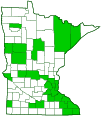camel crickets
(Ceuthophilus spp.)
Overview • Description • Distribution • Taxonomy
Description |
||
Ceuthophilus is a genus of large or medium-sized crickets. Adult males are ½″ to 1″ long. Females are larger than males. The head is oval shaped and is bent downward between the forelegs. The antennae are tapered and longer than the body, usually 2 or more times as long as the body. The body is stout and has a distinctive hump-backed shape. It may be whitish, pale brown, or almost black, with contrasting mottled markings. The egg-laying structure (ovipositor) on females is blade-like and straight. The legs are long and slender. The fourth segment of the leg (tibia) is longer than the third segment (femur). The tibia of each back leg is thick and has more than four pairs of movable spines. There is no spine on the front or side (dorso-lateral) surface of the tibia of the front leg. All legs have four end segments (tarsi). The first tarsus is almost as long as the remaining tarsi together. There are no wings or hearing organs (tympani). |
||
Distribution |
||||
|
Sources |
|||
| 7/12/2022 | ||||
Taxonomy |
|||
Order |
Orthoptera (grasshoppers, crickets, and katydids) | ||
Suborder |
Ensifera (katydids, crickets, and allies) | ||
Superfamily |
Rhaphidophoroidea (camel crickets, cave crickets, and cave wētas) | ||
Family |
Rhaphidophoridae (camel crickets, cave crickets, and cave wēta) | ||
Subfamily |
Ceuthophilinae | ||
| Tribe | Ceuthophilini | ||
Subordinate Taxa |
|||
black-sided camel cricket (Ceuthophilus latens) boreal camel cricket (Ceuthophilus brevipes) divergent camel cricket (Ceuthophilus divergens) fusiform camel cricket (Ceuthophilus fusiformis) pale camel cricket (Ceuthophilus pallescens) pale-legged camel cricket (Ceuthophilus pallidipes) plains camel cricket (Ceuthophilus pallidus) spotted camel cricket (Ceuthophilus maculatus) woodland camel cricket (Ceuthophilus silvestris) |
|||
Synonyms |
|||
|
|||
Common Names |
|||
This genus has no common. However, it contains most of the species known as camel crickets, and it is commonly referred to as camel crickets. That name is used here for convenience. |
|||
Glossary
Femur
On insects and arachnids, the third, largest, most robust segment of the leg, coming immediately before the tibia. On humans, the thigh bone.
Ovipositor
A tube-like organ near the end of the abdomen of many female insects, used to prepare a place for an egg and to place the egg.
Tarsus
The last two to five sections of an insect’s leg, attached to the tibia; the foot. Plural: tarsi.
Tibia
The fourth segment of an insect leg, after the femur and before the tarsus (foot). The fifth segment of a spider leg or palp. Plural: tibiae.
Tympanum
An external hearing structure. In reptiles and amphibians, the circular, disk-like membrane that covers the ear opening. In insects, the membrane covering the air sac and sensory neurons. Plural: tympani.
Visitor Photos |
|||||
Share your photo of this insect. |
|||||
| This button not working for you? Simply email us at info@MinnesotaSeasons.com. Attach one or more photos and, if you like, a caption. |
|||||
Brandi |
|||||
 |
|||||
Troy Bauer |
|||||
I came across your page while looking for information to identify a strange looking critter. I am 49 years old and still in the same small rural farming community I grew up in. I have never seen one of these weird little critters. It is a camel cricket or spider cricket. I see on your distributing map that my area does not show them. I am in Kenyon, MN and it is confirmed that they are certainly here now. Great site. Keep up the good work. |
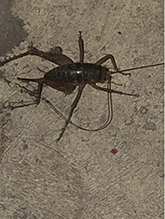 |
||||
Jason and Amanda Alexander |
|||||
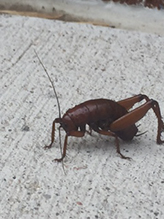 |
|||||
Bill Reynolds |
|||||
| While trapping pocket gophers in my garden, this little fella hopped out. | 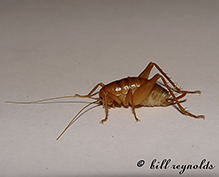 |
||||
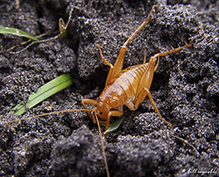 |
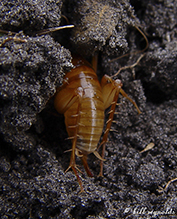 |
||||
MinnesotaSeasons.com Photos |
|||||
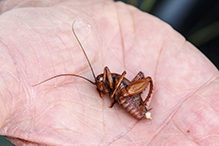 |
|||||

Slideshows |
||

Visitor Videos |
|||
Share your video of this insect. |
|||
| This button not working for you? Simply email us at info@MinnesotaSeasons.com. Attach a video, a YouTube link, or a cloud storage link. |
|||
Other Videos |
|||
| Cave Cricket (Camel cricket) Ceuthophilus sp. The Wimberley Naturalist |
|||
About
Published on Jul 13, 2014 This is a male Cave Cricket (or Camel Cricket) we found in the bathroom today. Cave crickets lack wings, and have a distinctive hump and downward-facing face, very long antennae and long legs, which enable them to jump quite high and far. The males of this species cannot chirp like other species can. Like their name implies, they can often be found in caves (and have a hump), and like most crickets are nocturnal (which is why this guy keeps out of the sunlight in the video). They also prefer dark, damp, cool environments (like caves!), which is why it was in the house, the bathroom specifically. It has been averaging in the mid to high nineties (Fahrenheit) outside lately and hasn't rained in weeks. Plus Texas is still going through a severe drought for the past several years. Cave crickets can damage cloth instead a home, like carpets and drapes. They also will eat just about anything edible, from decaying plant matter to dog food. These insects can actually become a pest and invade dark, damp areas of a home, like a basement. This video is short but captures this neat-looking insect. |
|||
| Camel Cricket (Rhaphidophoridae: Ceuthophilus) Dorsal View Carl Barrentine |
|||
About
Uploaded on Sep 9, 2011 Photographed at Grand Forks, North Dakota (07 September 2011). |
|||

Visitor Sightings |
|||||
Report a sighting of this insect. |
|||||
| This button not working for you? Simply email us at info@MinnesotaSeasons.com. Be sure to include a location. |
|||||
| Brandi 7/11/2022 |
Location: Centennial, Colorado |
||||
| Margo Bremer 6/21/2019 |
Location: Zumbrota, MN We live in the country, close to the Zumbro River. I have seen camel crickets in our basement once or twice a year over the last few years, and being a nature lover, I capture them and set them free outside. This last one I discovered in our basement shower. |
||||
| Troy Bauer 8/12/2018 |
Location: Kenyon, MN I came across your page while looking for information to identify a strange looking critter. I am 49 years old and still in the same small rural farming community I grew up in. I have never seen one of these weird little critters. It is a camel cricket or spider cricket. I see on your distributing map that my area does not show them. I am in Kenyon, MN and it is confirmed that they are certainly here now. Great site. Keep up the good work. |
 |
|||
| Jason and Amanda Alexander 9/2/2016 |
Location: Centennial, Colorado |
 |
|||
| Bill Reynolds 10/3/2014 |
Location: Pennington Co MN While trapping pocket gophers in my garden, this little fella hopped out. |
 |
|||
MinnesotaSeasons.com Sightings |
|||||

Created 10/3/2014
Last Updated:
